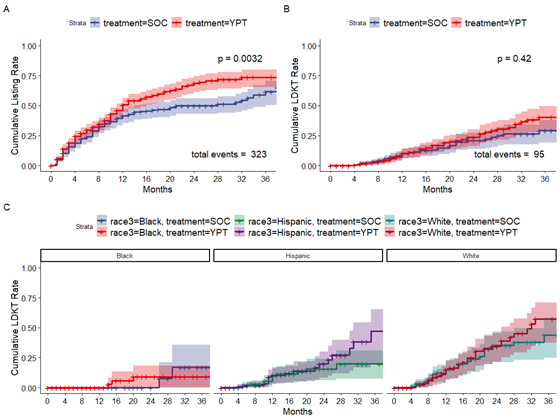Your Path to Transplant Tailored Education Increases Living Donation Transplant Actions and Wait-Listing Rates: Final Randomized Controlled Trial Findings
A. Waterman1, Y. Cui2, J. L. Beaumont2, J. D. Peipert3, A. Paiva4, M. L. Robbins4
1Transplant Research and Education Center, Los Angeles, CA, 2Terasaki Research Institute, Los Angeles, CA, 3Feinberg School of Medicine, Northwestern University, Chicago, IL, 4Department of Psychology, University of Rhode Island, Kingston, RI
Meeting: 2020 American Transplant Congress
Abstract number: 239
Keywords: Kidney transplantation, Living donor, Psychosocial, Public policy
Session Information
Session Name: Kidney Living Donor: Selection
Session Type: Oral Abstract Session
Date: Saturday, May 30, 2020
Session Time: 3:15pm-4:45pm
 Presentation Time: 3:39pm-3:51pm
Presentation Time: 3:39pm-3:51pm
Location: Virtual
*Purpose: Tailoring education and behavior change interventions to address gaps in individual patients’ knowledge, readiness, and socio-economic challenges may help more end-stage kidney disease patients pursue deceased and living donor kidney transplant (DDKT and LDKT). Your Path to Transplant (YPT) is an individually tailored, computerized education and coaching program delivered to patients pursuing transplant over 8 months. A randomized controlled trial assessed its impact on taking actions towards LDKT, becoming wait-listed and/or receiving DDKTs or LDKTs compared to standard of care (SOC) education provided at University of California, Los Angeles Kidney and Pancreas Transplant Program (UCLA-KPTP).
*Methods: Patients’ electronic medical records and linked outcomes data from the Scientific Registry for Transplant Recipients were reviewed 18 months after enrollment ended.
*Results: YPT patients were more likely to share education materials about LDKT with people in their life (86% vs 67%), ask potential donors to be tested (71% vs 54%), and share their need for a living donor with a large online community (44% vs 27%) compared to SOC patients. Of 802 randomized patients, 323 (40%) were successfully listed for DDKT, with YPT patients more likely to be listed than SOC patients (45% vs 35%, HR=1.39, 95% CI: 1.12-1.74, p=0.003, Figure A). Ninety-five patients received LDKT and 41 DDKT, with no difference in LDKT rates in the YPT (13%) and SOC groups (11%, HR=1.18, 95% CI: 0.79-1.77, p=0.42, Figure B).
*Conclusions: While the interaction between YPT and race was not significant for either wait-listing or LDKT, a clear racial/ethnic disparity in LDKT is present (p<0.001, Figure C). YPT is an effective approach to help potential recipients explore LDKT and become successfully waitlisted. More is required to overcome the LDKT disparity and find potential living donors to increase LDKTs.
To cite this abstract in AMA style:
Waterman A, Cui Y, Beaumont JL, Peipert JD, Paiva A, Robbins ML. Your Path to Transplant Tailored Education Increases Living Donation Transplant Actions and Wait-Listing Rates: Final Randomized Controlled Trial Findings [abstract]. Am J Transplant. 2020; 20 (suppl 3). https://atcmeetingabstracts.com/abstract/your-path-to-transplant-tailored-education-increases-living-donation-transplant-actions-and-wait-listing-rates-final-randomized-controlled-trial-findings/. Accessed December 24, 2025.« Back to 2020 American Transplant Congress

